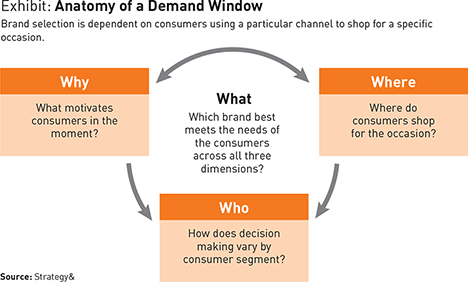Connecting the Dots from Brand to Demand
The best consumer strategies start with knowing where and why people shop for your product.
The notion of a typical consumer, one whose gender, age, ethnicity, and zip code can be used to make reasonably accurate assumptions about purchasing behavior, is a thing of the past. The most predictable characteristic of today’s consumers may actually be their variability — they’ll choose different brands depending on where they are shopping and the occasion they are shopping for. This trait is a logical extension of today's retail environment: Many consumer packaged goods (CPG) categories now consist of hundreds of brands, and new niche products launch every week. People can shop at supermarkets, warehouse stores, convenience stores, and a huge array of e-commerce sites. And there are far more ways for marketers to engage with shoppers, including mobile apps and social media.
Given this complexity, it’s more critical than ever for brands to find consumers in the moment. Doing so requires a more integrated view of what drives choice, one that isn’t tied to one-dimensional demographics or a narrowly defined need. Companies have to combine a deep knowledge of who is shopping, and when, and where, and why, with an understanding of the emotional and functional benefits of their products. As you make those connections, you gain insight about specific situations, or demand windows, in which consumers want or need to make a purchase. These windows open and close based on different factors at different times. Someone shopping for sandwich ingredients may choose one brand of deli meat when planning a child’s school lunch during a grocery store trip, but another when stopping at a deli to prepare a quick, healthy snack at home. Context is everything.
Demand windows create opportunities to drive better targeting and engagement along the path to purchase by more directly linking brand, consumer, channel, and occasion (see exhibit). The concept is gaining traction among CPG leaders, but it’s equally relevant across industries: Nearly every company needs to understand the way people evaluate products and make decisions. Yet the concept will have value only if it changes the way companies execute their strategy. They’ll need to identify those windows that are most promising for their brands, and then make changes in how they market and sell their current products, as well as develop new ones. The companies that get it right will dramatically improve the way they interact with consumers.
Past Is Prologue
A look at two large retail categories reveals how demand windows work in crowded markets. The first is beer, a category with a wide range of brands, styles, and price points. Some consumers prefer an easy-to-drink domestic beer when watching a football game at home but upgrade to a more complex craft brew that pairs well with a meal at a restaurant. The second is diapers, another category rife with options. Some consumers will buy a premium natural brand of diaper for a newborn, and then focus on durability when their child begins crawling.
Demand windows drive better engagement by linking brand, consumer, channel, and occasion.
The retail channel — and specifically the range of available options at a given location — also affects shoppers’ decisions. Consumers may go to a large upscale grocery chain with a huge selection of craft brews over the weekend, but then stop after work at a local corner store with a much smaller selection. Consumers may always pick up a jumbo pack of diapers at the big-box store or when buying online, but, knowing the per-diaper price is high, will look for a small package at the convenience store when they’re in a pinch.
Companies learn about consumers’ penchants and practices by looking at data on what they’ve bought in the past. That data, and the ability to mine it for useful insights, enables companies to understand the demand windows for their products. Only a decade ago, companies looked primarily at consumer surveys. Today, they still look at survey results. But they can overlay that information with detailed data about consumers’ online behavior — their browsing history, purchases, online reviews, and social media activity — plus metrics that track their behavior inside physical stores.
Seeking out demand windows isn’t the same as chasing the next shiny thing in digital marketing technology.
The good news is that the technology required to identify demand windows is not cutting-edge. In other words, seeking out demand windows isn’t the same as chasing the next shiny thing in digital marketing technology. To be sure, you need strong analytics capabilities or you risk falling behind. But you can build these capabilities by applying established quantitative marketing techniques in innovative ways that integrate and exploit a broad set of data sources.
The Execution Challenge
To implement a strategy based on demand windows, start with the following three steps:
1. Identify your ideal windows. Any given product has a long list of potential demand windows, but only a select few are the right choice for your company. The winnowing process begins with a clear understanding of your company’s own capabilities. There will be specific things that your brand is known for and that your company does best, whether it’s new product development, innovative packaging, or something else. Certain demand windows will naturally be a better match with these areas. For example, a craft brewer might specialize in creating new beers with higher alcohol content. Many beer drinkers in that region undoubtedly buy canned beer on sale at the convenience store before local sporting events. But the brewer would rightfully decide not to compete in that market. The capabilities fit just isn’t there.
At this early stage, you also need to make sure that the market size of a particular demand window is sufficient to justify the effort required to target it with current products or to develop new ones for it. Analytics can help you gauge the potential profit available from various options, through market simulations, scenario modeling, and other similar tools.
2. Tailor your sales and marketing approach. A detailed understanding of demand windows allows you to engage consumers in a way that a company using old segmentation approaches cannot. The right channel and marketing strategies can help you engage the consumer at the right places and times, resulting in more authentic connections and higher sales.
Consider, for example, promotions and other related content that create a more personalized experience for consumers rich and relevant to their specific interests. One company recently developed a new type of scissors, which it marketed and sold through separate campaigns aimed at craft hobbyists, students, and office workers. The company tailored its channel and marketing strategies, including decisions about which stores to sell in, promotions, coupons, packaging, and digital advertising, to serve these different consumers and their different occasions. It even segmented user reviews to ensure that hobbyist consumers, for example, saw only the reviews from hobbyist users. The result was a huge increase in sales compared with previous product launches.
Once you have used demand windows to shape your sales and marketing strategy, employing analytics enables you to measure the results of specific initiatives more accurately. For example, your company might run thousands of promotions in a given year. By staging experiments, such as testing new copy on a digital promotion aimed at a specific demand window and quickly gauging the results, you can improve the effectiveness of your next promotion in weeks, rather than months.
3. Innovate to create new products and services. Beyond improving marketing strategies for current products, demand windows can help companies develop new products. They are able to create products with the features consumers want, delivered in the right context to enhance their emotional connection, rather than simply making incremental improvements. For instance, if a diaper manufacturer with strong capabilities in sustainable manufacturing identifies a demand window for new parents looking to reduce their impact on the environment, the company can focus its innovation efforts on minimizing materials and offering recyclable or biodegradable packaging.
Analytics will guide your efforts here. At a micro level, analytics can help you more precisely target innovation opportunities for your brand at the intersection of consumer, channel, and occasion that is right for your business. You’ll be able to more accurately predict what product to develop, and which consumers are more likely to purchase it. On a macro level, you can use analytics to better track your return on innovation investment through metrics such as time-to-market and R&D productivity.
Windows of Opportunity
To see how companies can bring it all together, using demand windows to connect with consumers and drive growth, consider a deli meat company that has strong capabilities in product packaging. It identifies parents looking to buy healthy products for their kids’ lunches as a high-potential demand window. Targeting this group of consumers requires a different approach from what the company would use if just considering simple demographics, for example, “What do kids of a certain age like to eat?” or “What are regional lunch meat preferences?”
Given its expertise, the company could focus on developing kid-friendly lunch packages. It would target traditional grocery stores, where many families do their big weekly shopping trip, creating in-store displays highlighting the fact that the product is small enough to fit in a lunch box, easy to open, appropriately portioned, and healthy. The company could then run promotions timed to the beginning of the school year, or over the weekend when parents are shopping for the coming school week.
Rather than looking for quick wins, companies can develop a more sustainable source of competitive advantage.
The company could also create original content to engage potential consumers in the demand window, delivered through digital channels — for instance, healthy recipes or blogs that tackle subjects such as dealing with picky eaters. To boost engagement, it could create a social media campaign, asking parents to send in pictures of the empty lunch boxes their kids bring home after school, indicating that the product was a hit.
In a crowded field, demand windows enable companies to find the consumers who are most likely to want or need their brand. Rather than offering quick wins, they can help companies develop a more sustainable source of competitive advantage that will bring growth and profitability. For company leaders, the message is clear: The consumers looking at your products online or on the shelf are individuals, with preferences shaped by who they are, where they are, and what they want or need at a moment in time. The more you think about them in this light, the more attractive your brand will become.
Reprint No. 17202
Author profiles:
- Emre Sucu is an advisor to executives in growth and go-to-market strategies for Strategy&, PwC’s strategy consulting group. Based in Chicago, he is a director with PwC US.
- Matthew Egol is a thought leader in digital strategy with Strategy&’s consumer markets practice. Based in New York, he is a principal with PwC US.
- Edward Landry is a leading practitioner in marketing and sales strategies for Strategy&. Based in New York, he is a principal with PwC US.




